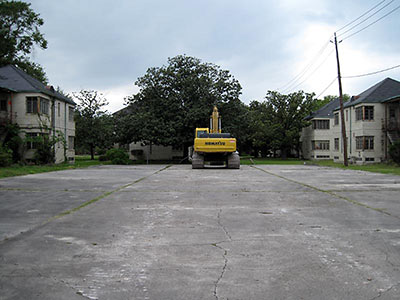
Note: Story updated below.
Over at Wilshire Village, all appears on track for one of those classic salvage-free start-over-the-weekend demos — the kind this town is famous for! A pre-demo sewer-disconnect permit for the apartments was pulled yesterday. And a Swamplot reader has sent in a photo report:
I saw that one of your commenters had noticed the Komatsu in the parking lot of Wilshire Village. It’s from Ambush Demolition, so that’s not a particularly good sign. There are numbers spray-painted on the sides of at least some of the buildings there and orange cable (and gas line?) markings on the sidewalks . . .
Will Wilshire Village’s actual demo permit be purchased sometime today? You’ll get a definitive answer . . . in next Monday’s Daily Demolition Report, right here on Swamplot!
Now, about that closeup:
***
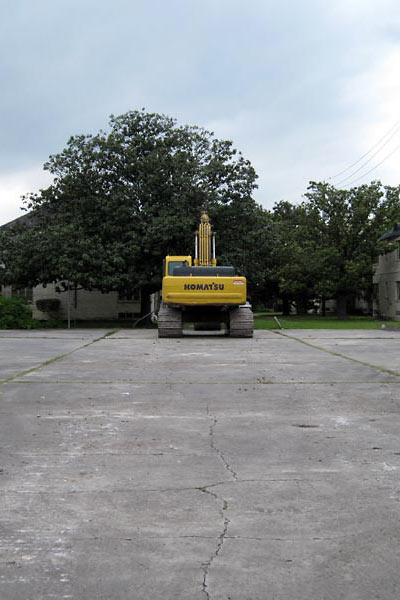
And now how about one for one of the buildings, too? Maybe number 9?
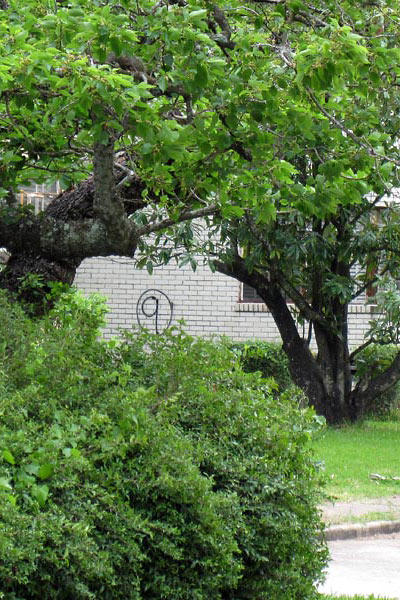
Update (and Monday Daily Demolition Report spoiler): No demo permits for Wilshire Village were issued Friday.
- Wilshire Village [HAIF]
- Okay, How About the Wilshire Village Apartments for Salvage? [Swamplot]
- Wilshire Village coverage [Swamplot]
Photos: Swamplot inbox


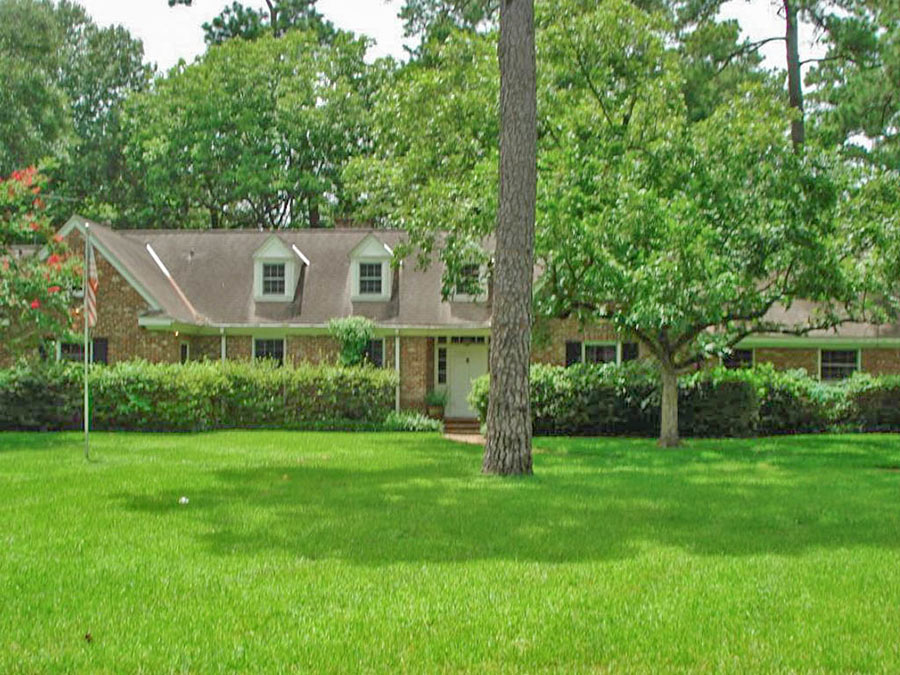

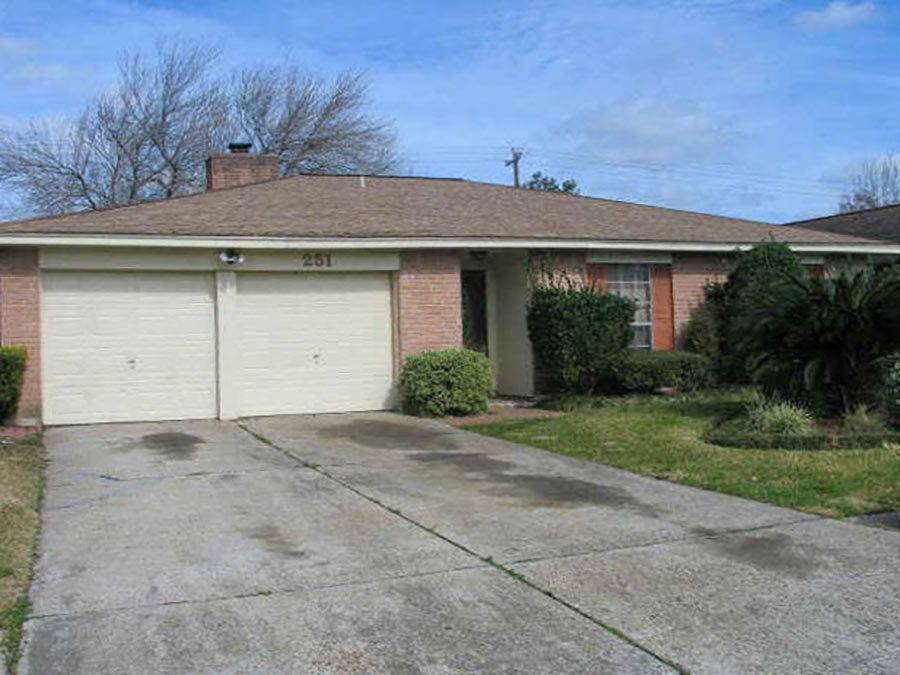
Jiminy Cricket! Enough about Wilshire Village already.
Well, Nick, you may soon get your wish.
At the beginning of February, 2009, about 30 adults and some children were living as tenants at Wilshire Village Apartments. The original owner, Jay H. Cohen, inherited the apartments and property from his parents, who had the apartments built in 1940. In November 2005, Matthew Dilick partnered with Cohen under a partnership called Alabama & Dunlavy, Ltd., taking out a loan to pay for taxes. Through this partnership, Dilick was able to obtain general partnership status to make management decisions, and his widely published plan all along has been to demolish the buildings and sell the land. Before the apartments could be demolished, they would have to be vacated. But the original owner Jay H. Cohen maintained majority ownership and wished to keep the buildings standing. Toward that goal, Cohen obtained two repair permits in January and February 2009 and set electricians to consistently making electrical repairs over the course of the next couple of months.
Toward Dilick’s goal of vacating the apartments, a series of events unfolded. Questions: If the buildings were demolished and new condos were built, would the City of Houston stand to profit by the increased value of the land and therefore increased taxes? Was the City of Houston working in coordination with Alabama & Dunlavy, Ltd to cause the buildings to be vacated? Why were Cohen’s repair efforts disregarded by Alabama & Dunlavy, Ltd. and the City of Houston? Has everything been legit?
2/2/2009 Notices of lease termination from Alabama & Dunlavy, Ltd. are received by tenants.
2/19/2009 Fire hazard placards are posted on the apartments by Fire Marshal.
2/24/2009 Doug Anders of the City of Houston’s Public Works and Engineering Department meets with the tenants of Wilshire Village Apartments, tells them that if they do not leave by Dilick’s deadline they will have their belongings thrown out on the curb by the Constables, and urges them not to pay rent for March 2009 (not mentioning that failure to pay rent is grounds for eviction).
3/2/2009 Letter are posted on the apartments, signed by City of Houston Building Official Gary Bridges and instructing Matthew Dilick to make repairs to the buildings. Dilick makes no repairs but Cohen continues the electrical repairs he has been making all along.
3/20/2009 Orders to Vacate are posted on the buildings, signed by City of Houston Building Official Gary Bridges, stating that the buildings pose an “immediate hazard to the occupants,†that they must be vacated by 3/31/2009, that utilities will be cut off 3/31/2009 at noon, and that anyone who remains occupying the buildings after that time will be subject to fines of $500 to $2000 per day. Although Chapter 10, Article IX, Division 4 of the City of Houston Code of Ordinances explains that an Order to Vacate cannot be posted until a hearing has been held before a neutral official who has not previously inspected the buildings, and the hearing official has considered the evidence of all interested parties (such as evidence of repairs), the City of Houston bypassed these requirements by using building codes that are only applicable to situations in which a building is an “immediate hazard.†Although none of the tenants felt that the buildings were actually an “immediate hazard,†the City of Houston was safe under the umbrella of sovereign immunity: in “emergency†situations, courts of law will not question the city’s judgment as to whether or not a situation was actually an emergency.
Late March – Vacate notices are sent to certain tenants from eviction cases filed by Alabama & Dunlavy, Ltd. The four remaining senior citizens are excluded (fear of bad press?), though still forced out of the apartments by the date posted in the City of Houston’s Order to Vacate.
3/30/2009 Two tenants go to eviction court, settle with Alabama & Dunlavy, Ltd. and thereby get an extension until 4/6/2009. Then the City of Houston posts new Orders to Vacate, stating that the tenants now have until 4/7/2009 to vacate due to immediate hazard. The eviction court does not have jurisdiction over the City of Houston, so the new Order to Vacate was not posted under authority of the eviction court. Apparently the immediacy of the “immediate hazard†diminished when Alabama & Dunlavy, Ltd decided to extend its cutoff date another week. The City of Houston extended its date by a week as well. Coincidence?
Also, why was it necessary for the tenants to sign a Full Release Form & Discharge, which refers to the tenants as “reported occupants†and which “releases and discharges Owner in full and waives any and all right or claim†in exchange for $500 (and moving expenses paid to some)?
This comment is posted by an anonymous news reporter/non-resident of Wilshire Village.
Is losing this complex a bad thing? Who wants to live in a 1940’s apartment, there is no telling what kind of toxic materials are in that place. Tear in down already!
“Doug Anders of the City of Houston’s Public Works and Engineering Department meets with the tenants of Wilshire Village Apartments, tells them that if they do not leave by Dilick’s deadline they will have their belongings thrown out on the curb by the Constables, and urges them not to pay rent for March 2009 (not mentioning that failure to pay rent is grounds for eviction).”
Amazing. But typical. Tenants cannot be forcibly removed without a writ. And of course Doug Anders know this. But of course he hoped the tenants didn’t.
It would have been interesting to see how a judge would respond had evictions been filed and the tenants all told the judge the city told them not to pay rent.
Of course if Dilick is a member of Houston Apartment Association, an attorney for Houston Apartment Association would have been there to remind the judge that the Texas Property Code does not apply to members of Houston Property Association.
I really hope someone pursues this – it just reeks of the corruption at work at City Hall.
What if anything have our esteemed members of City Council had to say about all of this?
Or have they been warned not to say anything at all?
I’m with Chester. The sooner they tear this dump down, the better. This place has been an eyesore ever since I moved to the neighborhood in 1992, and likely further back than that. If you love this place so much, you should have lived there while you had the chance. This reminds me of all the River Oaks residents who protest the possible loss of the River Oaks Theater, but they haven’t set foot in the place in over a decade.
This is private property. The owner should be able to do with it as he sees fit.
Property rights. Freedom. Capitalism. Anyone familiar with these concepts? These are the things that enabled Houston to develop into such a fantastic city.
“fantastic city”??
Bernard, do you *ever* get out for anything besides tea-bag protests? Do you even *have* a passport?
Houston is a mediocre city at best, an overblown and corrupt piece of urban sprawl at worst. This city was created by a couple of real estate swindlers from New York and bloated into its present state by people whose sole concern was/is turning oil into money. This childish notion that property rights trump all is completely typical of what is wrong with Houston– and precisely how this tragedy evolved in the first place.
And, yes… it is a tragedy. You may perceive Wilshire Village as an ‘eyesore’. Many others may feel that a more appropriate description for whatever tacky, blinged-out crap Matt Dilick decides to build on the grave of an irreplaceable piece of vintage early 20th century architecture. This is, after all, the man who brought us the Kemah Boardwalk.
One of the things that attracted me to Montrose when I moved here in ’78 was the fact that it was one of the few places in Houston where you could actually live in a building that was more than twenty years old. I was also encouraged by the preponderance of gays, punks, and artists and the scarcity of Republicans.
Obviously a lot has changed since then, and the neighborhood I’ve loved has been gentrifying out from under me since at least 1992. The destruction of Wilshire Village is going to accelerate the process.
I have nothing but sympathy for those who have been driven from their homes at Wilshire Village, nothing but contempt for Jay Cohen’s incompetence and Matt Dilick’s veniality. I also have a deep and sad sense that I am losing my home as well…it’s just taking a little longer.
Where’s the evidence that Jay Cohen is a partner in Alabama & Dunlavy? I’ve seen that tossed out a few times, but haven’t seen anything solid to back up the claim (and I’m not willing to send money to the Secretary of State to get the partnership details). Same thing for the alleged bank loan on the property? What’s the source?
Eloquently put M. Martin. Thank you..and also thank you for the FPH article.
“This city was created by a couple of real estate swindlers from New York….”
Shhhhhhh. We’re not supposed to talk about the Allen Brothers. Besides, it’s a matter of perspective. If you ignore the 150% humidity, the prehistoric mosquitoes and tree roaches, known to natives simply as flying cockroaches, the roaches that is, and the occasional hurricane, this really is a tropical paradise. Just like they said it was. A tropical paradise nestled along the banks of a tree-lined bayou. And every swindler on earth has loved it here. We are easy as they say.
As for Wilshire Village, it has no historic value. Nothing in Houston does. We learned that when they tore down the Shamrock. If the Alamo were here and someone wanted to build something else, they would tear down the Alamo. They. The developers. They are kings. Well, they at least pay a king’s ransom to the mayor, whoever he or she may be at any particular time, in order to get whatever they want.
And those who don’t pay don’t get to play. As the developers of 1717 Bissonnet found out.
Property rights do exist. You just have to pay for them. By buying City Hall.
What Wilshire Village does have is sentimental value. Memories. Of a time when Houston was a pleasant place to live and there were pleasant places to live. Apartments that looked out on gardens. That had kitchens instead of kitchenettes. That had front doors and back doors. That had windows in the bathrooms. That had some feel of a home instead of a sardine can. But some like the sardine can. Simply because the sardine can is expensive and people will think they are a success because they are living in the sardine can. And the developers love the sardine can because if offers maximum profit off minimum space. As no doubt we will see once again with whatever replaces Wilshire Village.
As for Mr. Dilick, obviously he bought City Hall to pull this off. Hope everyone remembers that next time at the polls.
Hey Bernard and Chester, yous two should go pound sand out in Katy. People like yous two have pretty much ruined my neighborhood over here in the 019.
The nice thing about the toxic materials of the 40’s as compared to the materials of today? They are a known quantity.
Matt, thanks for clarifying that tenants cannot be forcibly removed without a writ, and that the tenants were therefore mislead when told by a city official that if they did not leave by Dilick’s deadline they will have their belongings thrown out on the curb by the Constables.
Also, I want to clarify my comment regarding the Order to Vacate, as to how the City of Houston was able to bypass the requirements of Chapter 10, Article IX, Division 4 of the City of Houston Code of Ordinances which states that an Order to Vacate cannot be posted until a hearing has been held before a neutral official who has not previously inspected the buildings, and the hearing official has considered the evidence of all interested parties (such as evidence of repairs). In declaring on the Order to Vacate that the buildings posed a “serious and immediate hazard,” The City of Houston bypassed the requirements of Chapter 10 by referencing Building Code Section 104.12, which states that “if the use (of the building) creates a serious and immediate hazard to life or property, the building official shall order the use discontinued immediately…” Building Code Section 104.12 is one of the City of Houston’s building code amendments which came into effect January 4, 2006. This recent amendment was used to great effect in vacating the remaining tenants of Wilshire Village Apartments. Will this amendment continue to be an effective tool in wiping out more of Houston’s historical buildings?
Also, the fine of $500 – $2000 for failure to vacate within the time prescribed on the Order to Vacate, is pursuant to Building Code Section 113.1 — another amendment which came into effect January 4, 2006.
“This recent amendment was used to great effect in vacating the remaining tenants of Wilshire Village Apartments. Will this amendment continue to be an effective tool in wiping out more of Houston’s historical buildings?”
Probably. Although really the city just does what it wants and allows developers to do what they want. And usually they get away with it.
Years ago during the “demolition derby” in Fourth Ward someone with the state historical commission contacted Houston Renaissance regarding the historical value of one particular structure, noting its containing very rare wood for one thing, and asked that the house be preserved.
That night neighbors watched as someone in a pickup truck wrapped a chain around a porch post and then hit the accelerator. Which resulted in the term “demolition derby” which occured frequently in Fourth Ward. The city of course came out the next day and condemned it. With the bulldozer already sitting in the yard.
Fourth Ward is a perfect example of how public-private partnerships work which all our mayors, Bill White in particular, claim is what makes our city so great.
One city councilmember during the course of the invesigation by the AG’s Office stated Houston Renaissance had spent $24.5 million in public funds, including Fannie Mae loans, to buy $6.5 million worth of land.
As if that wasn’t bad enough, the original HCAD records, before they were changed, indicated Houston Renaissance had bought land outside of Fourth Ward. They ran an imaginary line down West Dallas to create their TIRZ. Perhaps they were going to run it all the way down West Dallas to Shepherd to Richmond as well. Perhaps they thought a TIRZ could be drawn the way congressional districts are drawn.
No one knows how much was spent – apparently there was never a complete audit of both Houston Renaissance and Houston Housing Finance Corporation. Apparently the only audit that the city was required to provide was of the “public” part of the public-private partnerships.
And here we are years later watching the city at work once more. Business as usual. Monkey business as usual.
And the City of Houston has shown itself willing and able to pass tougher laws to expedite the demolitions. With the $500 – $2000 fine for staying in the apartments past the date on the Order to Vacate, the City of Houston made darn sure everyone would be out.
I posted this in the comments on the May 1 demo report, but it might get missed there so I’m putting it here too.
Visit the city’s permit search site, select Owner/Occupant, type in WILSHIRE VILLAGE, and pick a begin date of April 1 2009.
There’s a DEMO BLD/SEWER DISC permit for each of BLD 1 thru BLD 15, plus a couple of other miscellaneous demo permits masquerading as plumbing permits. These were all issued last Monday, April 27th. I think only the torrential rains are keeping these buildings standing now.
Several of the windows have been removed, and by “window” I mean the entire thing, glass, frame, and all. I can only hope that someone is sneaking onto the property and conducting a little midnight “removal to preserve”.
more liter flinging, since i moved out of there back in february, i drove by last week to look at the place. as sad as all this was, i couldn’t help but laugh when i saw the mural sized graffiti on most of the buildings, rocks thrown through most of the remaining windows, tree limbs everywhere, weeds grown up to 2 feet and huge mounds of dirt piled up in front of some of the doors. gracious piles of trash thrown over the fence baracade and a littering of beer cans everywhere.
all those neighbors who vented our complex was an eyesore…WELL HOW DO YA’ LIKE IT NOW? ROFL
ya got what ya wanted. we’re all out of there now you have a Cohen-Dilick ghetto party place.
may the rats be with you.